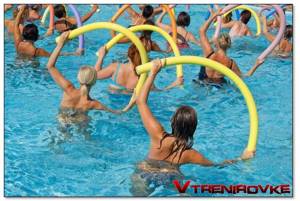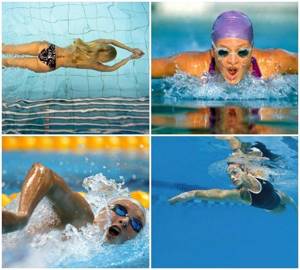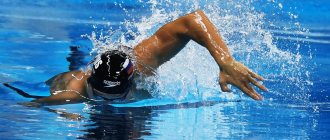2458
Swimming is a very enjoyable and affordable way to get rid of extra pounds. You can find out in advance how many calories are burned when swimming. It helps to create a training schedule and carefully work out the exercises to get the maximum benefit from your sports activities. Information is widely available - it is always possible to find out how many calories can be removed by swimming, which styles use more or less energy, how weight loss will depend on the type of human figure.
Not everyone's ability to lose weight will be the same - people are often annoyed that some people manage to lose weight quickly, but despite all the efforts they put in, they can't get very far. It should be noted that success is not always achieved in a short time and will not be the same for everyone.
While some people manage to noticeably lose weight after a week or two of exercise, those with an endomorphic figure, for example, have to put in more time and effort. They may require additional stress to achieve the desired result. Nevertheless, exercises in the pool invariably bring good results, so you should not neglect them.
HOW MANY CALORIES CAN YOU BURN IN A POOL?
There are several answers to this question. Everything is connected and depends on the type of activity you are doing and, of course, the time spent on this activity.
HOW MANY CALORIES CAN YOU BURN IN A POOL?
Also, a lot depends on what kind of water you are in when doing a certain type of exercise. Well, let's look at several cases in which we find out how many calories are burned when swimming in the pool .
How does temperature affect
Water temperature has a direct impact on losing extra pounds. The pools are mostly heated, so the water temperature reaches up to 29 degrees. This is very comfortable, but not as effective for weight loss as we would like. After all, such comfortable water will not require any extra expenditure of energy; it will relax and unwind. Therefore, it is worth remembering that the effectiveness of weight loss exercises is achieved at 26-27 degrees. Unplanned expenditure of energy to maintain temperature forces the body to waste fat resources, and it simply “melts”.
CALORIES BURNED IN AN HOUR OF SWIMMING
Of course, we all understand that we cannot give an unambiguous answer to the question of calorie burning with specific numbers. This is due to the fact that exercises can be performed with greater or lesser load and intensity. It turns out that we cannot predict the exact intensity of the exercises. But we can still come up with more or less approximate figures.

CALORIES BURNED IN AN HOUR OF SWIMMING
Well, how many calories are burned during an hour of swimming ? If we are talking about simple swimming, in which we do not perform certain exercises and simply swim moderately for pleasure in the aquatic environment, then with such swimming it is quite possible to burn about 400 calories in an hour of swimming. It is worth remembering that everything depends on the intensity of swimming, therefore, you can burn more calories if you simply swim more intensely.
If we now know the approximate number of calories burned at an average intensity of swimming, then it is worth talking about how much can be burned at a low intensity of swimming.
If we just came to some body of water to relax or to the pool, to simply refresh ourselves on a hot day, and do not plan to purposefully load our body with intense swimming, then in any case we can burn about 200 - 250 calories while same hour of sailing.
How to properly burn calories in water
If we have problems with excess weight, then by simply spending time in the water, we can also burn a fairly large number of calories, not to mention targeted and persistent training in the pool, and perhaps even with a trainer. For that matter, specificity in such things is never superfluous.

How to properly burn calories in water
For some people, specificity is a very strong motivator to take action and train harder not only in swimming and water sports, but in any other activity. Be it knowledge of possible results, or the same salary at work. This is not something surprising or strange. If a person knows what he is going to, and this result suits him, then he will do everything possible with all his might to achieve the desired result.
In our case, such an important motivator is knowing how many calories swimming burns . Knowing how much we can burn in a certain amount of time and under certain conditions, we can analyze the results that we have already achieved and the results that we still have to achieve.
CALORIES BURNED BY SWIMMING IN 40 MINUTES
We often come to the pool for a session, which requires a certain amount of time spent in the pool itself. That is, directly, you often have to swim for less than an hour. The time spent in the aquatic environment is approximately forty minutes. Then a completely logical question arises - how many calories are burned when swimming for 40 minutes ?

CALORIES BURNED BY SWIMMING IN 40 MINUTES
If we talk about the same swimming, which we do precisely with the aim of increasing our level of physical condition, as well as losing weight, then when swimming for forty minutes you can burn at least 280 calories. Again, the higher your swimming intensity, the more calories you will be able to burn. That is, it is quite possible to burn about 400 calories by swimming for forty minutes.
Swimming: Burn calories in the pool in 30-45 minutes, for an hour
How many calories are burned when squatting?
In order to achieve results in weight loss, you need to adhere to regularity in training and perform it well. To do this you need:
- While in the water, keep your body in constant tension, which burns calories. Of course, it is necessary to take breaks, but not long and not often.
- Change swimming styles, move from one to another, for example, first breaststroke, then backstroke, then change style again.
- Eat right, you need to eat 1.5 hours before training and refrain from eating after training for an hour. Nutrition must replenish the body's energy expenditure, it must be complete and balanced. You need to come to training well-fed. You need to exclude from your diet so-called appetite stimulants, such as ketchup, mustard, horseradish, seasonings, etc.
- Breathe correctly. Inhale through your mouth and exhale through your nose.
- Swim regularly, for 30-40 minutes, 2-3 times a week, and after a couple of months you can see results.
- Make sure to maintain a high body position on the water, because as you go deeper, the resistance becomes greater and the technique breaks down.
- It is recommended to swim with goggles, as without them an effective workout will not be possible. You need to choose glasses that fit tightly to your face.
SWIMMING IN THE SEA - HOW MANY CALORIES YOU CAN BURN
These cases that we examined applied exclusively to swimming in a pool or in a calm body of water. But when we are at sea, the benefits are much greater. Accordingly, the calories burned will also be an order of magnitude greater.

SWIMMING IN THE SEA - HOW MANY CALORIES YOU CAN BURN
All this is due to the fact that the sea and various thermal waters are enriched with various minerals, which have an extremely positive effect on the condition of the skin, and penetrate through the skin into the body. So how many calories do you burn when swimming in the sea ?
- If we talk about the same moderate intensity of swimming in the sea, then with an hour in sea water you can burn about 500 - 510 calories. And this is the minimum amount of calories burned. There are also various swimming pools in the world, which are directly enriched by people with many minerals and other useful substances.
In such pools you can burn approximately the same amount of calories, since the enrichment of these pools is carried out in order to bring the usefulness of the water as close as possible to sea water. If you increase your load and swim more intensely, you can burn more than 600 calories per hour of swimming.
What other benefits can you get from swimming?

Why swimming is good for you
Swimming is really very good for losing weight. But water procedures themselves are very useful - they will not only ensure the active burning of excess calories, but also have a positive effect on the functioning of all body systems as a whole.
When performing active movements in water, it is possible to relieve excessive muscle tension, significantly strengthen the heart muscle, and improve the functioning of blood vessels. Swimmers have a toned and flexible body; with regular exercise, these qualities are preserved and plasticity increases. Immunity improves, so the danger of getting ARVI is significantly reduced. Swimming has a positive effect on the functioning of the nervous system. Thanks to them, it is possible to restore mental balance and organize a pleasant, restful sleep, and good rest. Swimming will also help increase stress resistance.
In the pool you can easily burn off a significant amount of calories and also reap enormous health benefits. When swimming, the muscles of the legs are well worked out, the outer and inner surfaces of the thighs are noticeably strengthened, and the condition of the muscles of the shoulders, buttocks, and arms improves. Swimmers gain a perfectly flexible waist.
Training in water is much more effective than doing other sports. Swimming quickly will burn calories four times faster than running.
BREATH STROKE AND CALORIE RESET
In this case, we looked at examples of ordinary swimming in an aquatic environment, without performing any swimming techniques. But what if we use different techniques in our swimming? Different techniques are useful in their own way and, accordingly, when performing them, different amounts of calories are burned. Now we’ll find out how many calories are burned when swimming breaststroke .
If we want to take up swimming and have chosen the breaststroke technique for ourselves, then with forty-five minutes of hard swimming we can burn about 550 - 600 calories in a minimal amount. If you take up swimming using the breaststroke technique in the sea, the number of calories you burn will increase accordingly. This amount can reach up to 700 calories per hour of swimming.
Compliance with water safety regulations
Swimming in ponds requires special care, so you need to remember safety precautions. Signs prohibiting swimming, the topography of the bottom, the presence of broken glass and other debris in the water - all this should be in the attention zone of swimmers. It is advisable to choose reservoirs that are not remote, so that in case of trouble, help will come.
You cannot go to exercise on a full stomach, because, firstly, it will be very difficult to move, and, secondly, it is not good for digestion.
You need to remember that river and sea water does not warm up above 25 degrees, so there is a risk of getting a sudden leg cramp. This happens especially often when swimming in a lake, since lake water is much colder than river water. If seizures occur, it is better not to swim in the lake, or to swim accompanied.
FREESTYLE SWIMMING - BURN CALORIES
The next question that I would like to understand is how many calories are burned when swimming crawl ?

FREESTYLE SWIMMING - BURN CALORIES
As you know, the crawl technique is one of the healthiest swimming techniques. From this we can conclude that you can burn quite a few calories. When swimming breaststroke in the pool in an hour, it is quite possible to burn up to 650 calories. The more you try, the more calories you can burn.
Interval training to burn calories and lose weight
Interval training, the essence of which boils down to alternating the intensity of movements from maximum to minimum, will speed up the process of losing weight and burning calories.
- The duration of interval training usually takes 10-15 minutes and is carried out as follows:
- You should swim for 30 seconds at full strength with maximum energy expenditure, at a level of at least 90% of your own capabilities. The butterfly style is relevant.
- You should swim breaststroke for 15 seconds, focusing on a slow, relaxing pace.
- This alternation of possibilities will occupy one interval. The following interval training can be structured like this:
- 30 seconds – active work, 15 seconds – rest.
This is what the second interval looks like. During your first workout, it is enough to perform 10 similar intervals. Gradually, you can increase the number of intervals to 15.
Alternatively, you can start your interval training by swimming for 5-10 minutes in different strokes at your warm-up pace. You should swim backstroke, freestyle, butterfly and breaststroke.

How right!
Also one of the frequently asked questions is “What affects the number of calories burned during swimming?” This can be more easily answered.
The number of calories burned is affected by the chosen style. In addition, it is worth clarifying that a person’s weight plays a big role in calorie expenditure. The heavier a person is, the harder it is for him to stay on the water. This is why overweight people are able to lose more calories.
The progress of the workout is also one of the components in weight loss. If the workout takes place without rest, then the number of calories burned will be higher.
Swimming pace is also important. When swimming fast, a person's heart rate will increase. This means that muscle cells will absorb more energy, which will increase the number of calories burned.
The best pace for swimming is 2 kilometers per hour and above.
And of course, the chosen body of water plays a big role. As stated above. The first lessons should be carried out in the pool to learn swimming. After a person learns all types of swimming that are suitable for him and correct breathing. You can think about other bodies of water.
For example, in the sea you can lose up to 600 calories per hour, since thanks to the waves and current, the muscles have to resist, which means spending more energy.
In the river and lake you can lose up to 500 calories. But here it is better to choose a warm body of water, the temperature of which will be above 24 degrees. Because in a cold body of water the body is exposed to stress and the body begins to give off useful energy rather than subcutaneous fat.











